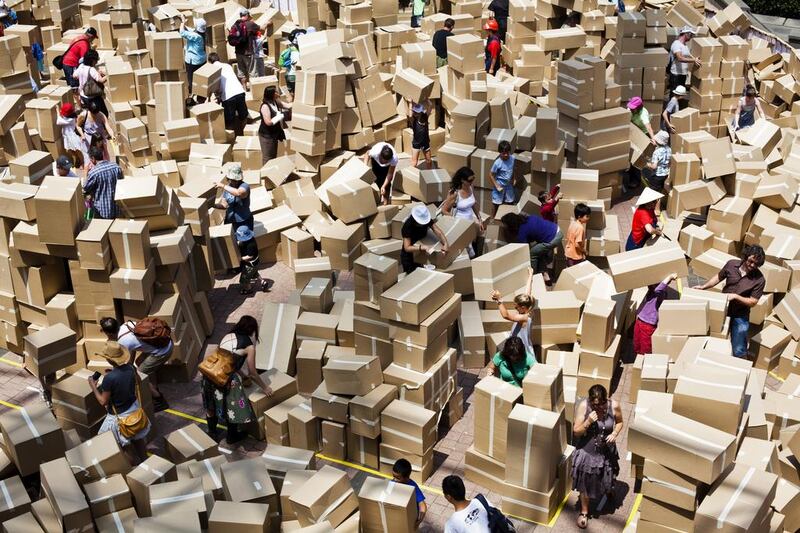From thousands of discarded cardboard boxes will rise a mini-city, complete with skyscrapers and bridges, on the grounds of New York University Abu Dhabi.
The international touring dramatic art installation We Built This City, by Australian-based Polyglot Theatre, will begin to take shape at NYUAD's arts centre from October 8. The live-art project, which relies solely on discarded packaging and the unbounded creativity of children, was designed by the company's artistic director, Sue Giles, to encourage unstructured play. It has toured all over the world since 2001, with imagined cities created by families in Australia, the United Kingdom and United States. With the support of a theatre crew, young and old residents participating in this free event will be guided in constructing shops, monuments and houses with cardboard, all of which will be torn down in a ceremonial fashion at the end.
What are my building blocks?
Big, tiny, broad and flattened boxes. Cardboard of all shapes and sizes will be at the venue for children to design their buildings with. Giles, who conceived the project after watching her kids play with cardboard boxes in the backyard, has seen all sorts of construction undertaken with the material in her work.
“You can spend days and days reimagining a cardboard box to get something really upscale, spectacular and striking for a public space,” she says.
Most of the cardboard is waste from manufacturers and packaging companies, which is then recycled. The theatre company has asked NYUAD to source three different sizes of boxes for the installation, and expect at least 6,000 boxes to begin with. “You need enough boxes but not too many because you need place for people to move around,” she says.
Not everything is supplied, however – Giles says all the families need to bring a playful spirit to the event.
“What we offer is the boxes. The detail and kind of complexity of what gets built is just with those materials,” she says. “There will also be flat pack boxes, so there will possibilities to make roofs and tunnels. We find that people get real detailed with intricacies in the way they put the boxes up.”
What are the rules?
All you need to do is respect other people’s creations, and just have fun. Giles says families mustn’t be fooled by the simplicity of the task: “It’s not until people have been there for a little while that they start to see how complex they can get with it.”
The cast from Polyglot will be on site as in-character construction workers to assist as families build their spaces. “They bring a kind of drama and help children engage with the idea of a city and what can happen in there.”
What can I build?
Take inspiration from the tall, futuristic buildings, vast shopping malls and bridges around town. The cities built around the world often represent the culture of the society.
“People build according to the city they’re in,” Giles says. “The psychology or the feel and kind of culture of the city becomes apparent in the buildings. So we are very interested to see what happens in Abu Dhabi because the city is so extraordinary.”
The time it takes to build the city can be anything from one day to two weeks, as was the case in the Australian city of Perth.
“It was very hot,” Giles says. “The children built tunnels that they could hide in, so we are expecting a lot of tunnels in Abu Dhabi, as well.”
Why is the city torn down in the end?
Guided destruction is therapeutic. Once the city is built, families remain to watch it come crashing down on the final day.
“We, young and old, are inherently rebellious. It’s like when you build a sandcastle and kick it down,” Giles says. “The idea of choosing your own point of destruction is quite a powerful feeling for a child and it imparts a sense of leadership with control. It’s not vicious or warlike. It’s an absolute joyous and profound moment.”
• We Built This City will take place from October 8 to October 11 and October 15 to 17. Tickets for the free event can be reserved at www.nyuad.nyu.edu.
aahmed@thenational.ae





